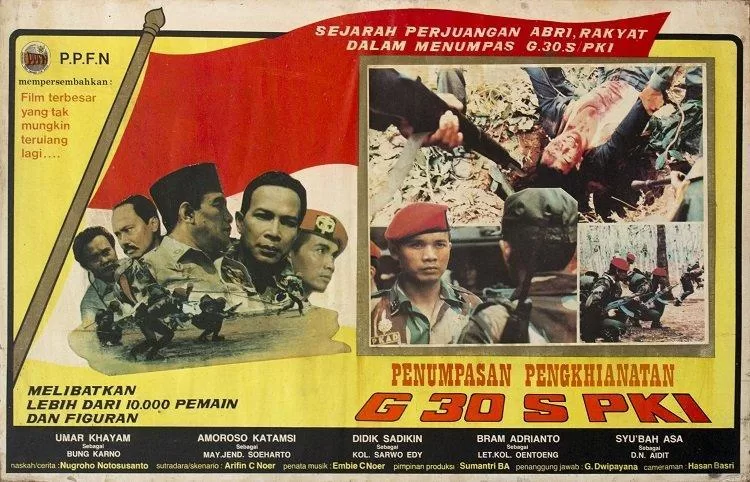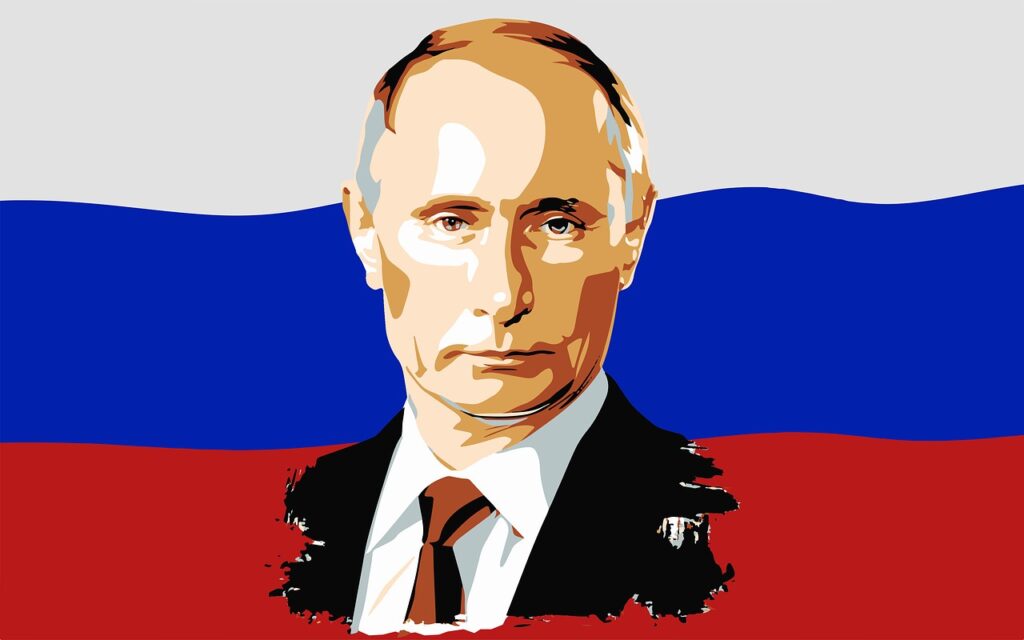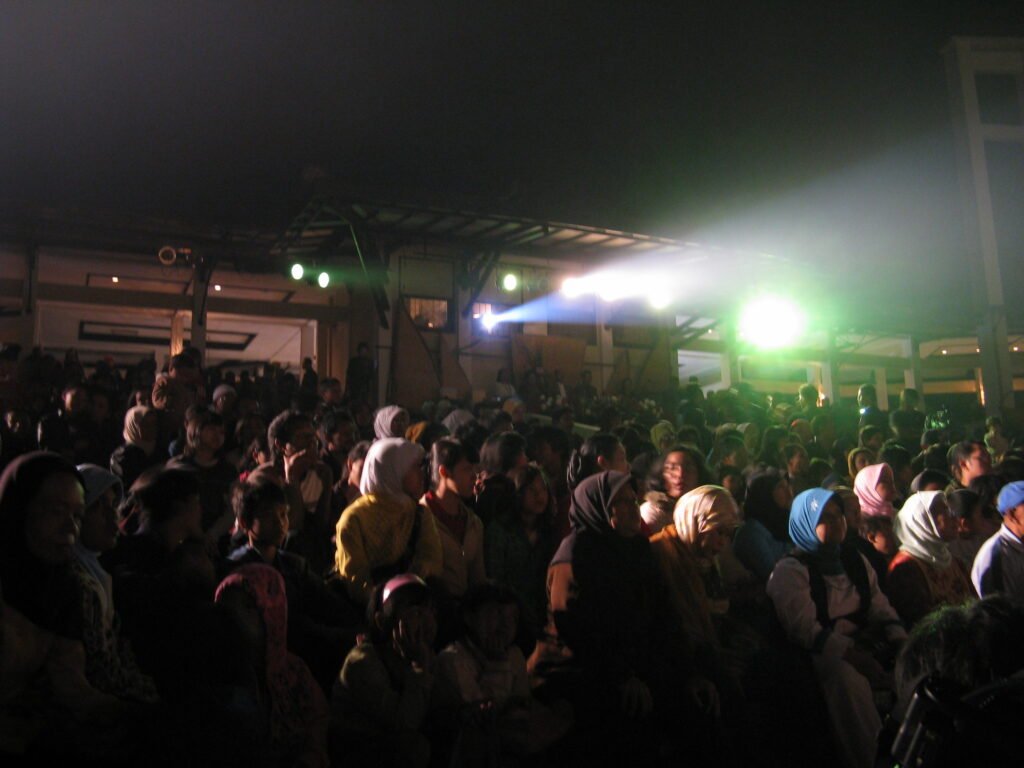History recorded mass killings in Indonesia in 1965. One particular anti-communist film haunted Indonesians for years afterward.
 A propaganda film constantly aired during a military regime in Indonesia : “Film, Teror Negara dan Luka Bangsa” by Historia magazine is available at https://bit.ly/3LgeYjE
A propaganda film constantly aired during a military regime in Indonesia : “Film, Teror Negara dan Luka Bangsa” by Historia magazine is available at https://bit.ly/3LgeYjE
History recorded mass killings in Indonesia in 1965. One particular anti-communist film haunted Indonesians for years afterward.
In January 2023, Indonesian President Joko Widodo disclosed the findings of the investigation team regarding past human rights violations. He acknowledged 12 gross human rights violations. The worst were the 1965-1966 massacres of Communists where approximately one million people died in state-sponsored political violence.
Like many other nations, Indonesia has a troubled and violent past. One so overwhelming the majority of the population continues to feel the repercussions daily. In some countries, the medium of film has emerged as a key platform where the nation learns to come to terms with its past in a collective fashion. Indonesia is one of the least prepared nations to do so, despite having a long and rich history of cinema.
The importance of links between film and the history of the 1965-66 massacres, which gave rise to Indonesia’s New Order regime under then-president Suharto (1966-98), cannot be overemphasised.
Contrary to the expectations of many who survived the New Order’s brutal repression, greater space for openness in public debate since the regime ended has not helped disclose the truth, build reconciliation, or helped the pursuit of justice.
The New Order’s propaganda remains largely intact. Worse, but not surprisingly, many younger Indonesians, who enjoy the power of new media and greater freedom of information, appear to have little interest in past political violence.
From the outset, Suharto’s government understood the power of cinema and propaganda. It made a huge investment in the anti-communism campaign through the notorious film Pengkhianatan G 30 September (The Treachery of the 30th September Movement). The government did all it could to have maximum control of public consciousness and discourse about the event by consistently imposing an official version of history.
On 15 April 1969, the Commander-in Chief of the Command for the Restoration of Security and Public Order (Komando Operasi Pemulihan Keamanan dan Ketertiban, aka KOPKAMTIB) issued an instruction for the establishment of a “KOPKAMTIB Film Project“, which would be responsible for producing “documentary films” as a “medium of psywar” against its enemies in Indonesia and overseas. Indonesia’s National Commission on Human Rights mentioned in its 2012 report that Kopkamtib systematically orchestrated the mass killings of 1965.
Pengkhianatan G 30 September was completed in 1984 after two years of production. Two years later another propaganda film was released: Penumpasan Sisa-sisa PKI Blitar Selatan (Suppression of Remnants of the Communist Party in South Blitar) or Operasi Trisula (Trisula Operation) (1986, Kadarjono), which depicted an extended witch-hunt of Communist survivors by the military in South Blitar, perceived to be the last of the Communist hideouts.
In 1988, the New Order government produced yet another propaganda film: Djakarta 1966 (1982, Noer), which focused on the controversial transfer of power from President Sukarno to Major-General Suharto. At the core of the controversy is the issue of a Presidential Instruction on 11 March 1966, signed by Sukarno, and its use or abuse by Suharto.
No other propaganda material, on or offscreen, has generated a similar impact to Pengkhianatan G 30 September. The film broke records in terms of runtime (nearly 4.5 hours), the number of supporting actors (10,000) and viewers, as well as scoring record financial investment and revenue. School children were required to buy tickets to watch it during school hours. Despite its marathon length, the story concerns only a five-day period between 30 September and 5 October 1965.
The film is completely silent about the second episode (the massacres), although the less known sequel Penumpasan Sisa-sisa PKI Blitar Selatan (Suppression of Remnants of the Communist Party in South Blitar, 1986, Kadarjono) glorifies the destruction of the fleeing Communists.
More important than the record-breaking statistics is the fact that for at least the first decade of its circulation, the film was the primary, or the only available, source of detailed information for most Indonesians about what might have happened in September to October 1965.
The state television network, TVRI, broadcast the film each year on 30 September until the collapse of the New Order in 1998. Private television stations were required to follow suit. The film established the central and overarching framework for any public discussion for most of the New Order period. Any public expression that implied doubt on the validity of the official history of 1965 or referred to alternative narratives among scholars overseas was declared against the law and was liable to criminal prosecution.
Notwithstanding such intimidation, dissenting voices emerged from time to time during the New Order rule, if only to be immediately suppressed. This suppression has continued more than a decade since the downfall of the New Order.
For many Indonesians, Communism was, and remains, a taboo subject for any critical discussion and the word “Communist” functioned as a popular derogatory term.
Indonesia’s respected media Tempo and Kompas conducted surveys on the most serious threats to Indonesia. In August 1985, in commemoration of the 40th year of Indonesian independence, over one third of Tempo‘s respondents picked the resurgence of the Communists. More than half of these respondents were between 21 and 30 years old.
The daily Kompas conducted similar polls in 2002 and 2003, and the results affirmed the Tempo survey. In 2000, Tempo held another round of polls, canvassing 1,101 secondary school students on where they had learned the history of the 1965 events; 90 percent responded “film”. As there was only one film on the subject, there is no ambiguity as to which film they were referring to. As many as 97 per cent said they had seen Pengkhianatan G 30 September. Asked how many times they had seen it, 38 percent of respondents had seen it more than three times.
Despite new media and an enlarged space for freedom of expression, only a small proportion of post-1998 films have revisited the 1965 tragedy. This should not be surprising, as the younger generation has no reason to be particularly interested in such a heavy and depressing theme. Out of approximately 1000 short and documentary films per year, only slightly over a dozen titles were specifically dedicated to revisiting this contentious historical period of the first decade of this century.
Apart from political censure, any film revisiting the 1965 violence content-wise must confront a set of dilemmas that arise from the complexity of the subject matter and the unpreparedness of many of the Indonesian audience to deal with it.
Any narration — in film or other medium — of the complex and highly contentious issue of the 1965 violence for an Indonesian audience will be confounded by the fundamental problem of having to draw a narrow focus around particular fragments, and privilege particular perspectives with political significance at the expense of others. Even under the most ideal and liberal circumstances, narrators must choose to focus on certain selected aspects and leave other issues unaddressed, sidelined, or in the background, thus risking problems of effective communication with the audience.
Indonesia remains unable to resolve, ignore or forget the multiple issues related to its violent past. Denials and repression of the issues have been the standard strategy. This has been responsible, at least in part, for the tendency to view the rise of Islamisation in an ahistorical fashion and the failure to recognise and control the legacies of past violence and impunity that has spilled into contemporary politics.
Unsurprisingly, we witness ordinary Indonesians reacting with consistent bewilderment and paralysis when confronted by the cycle of communal conflicts and fatalities over the past half a century.
Ariel Heryanto is a Professor Emeritus, Monash University, Australia. His interests are in cultural studies, media studies, and postcolonial studies. This article is derived from a chapter in his book Identity and Pleasure: The Politics of Indonesian Screen Culture (2014). The original research for this piece enjoyed funding from The Australian Research Council. Other supporting bodies are mentioned in the book’s Acknowledgement.
Twitter @ariel_heryanto
Originally published under Creative Commons by 360info™.









